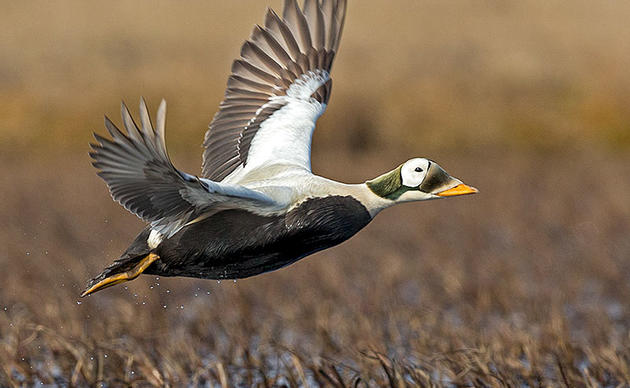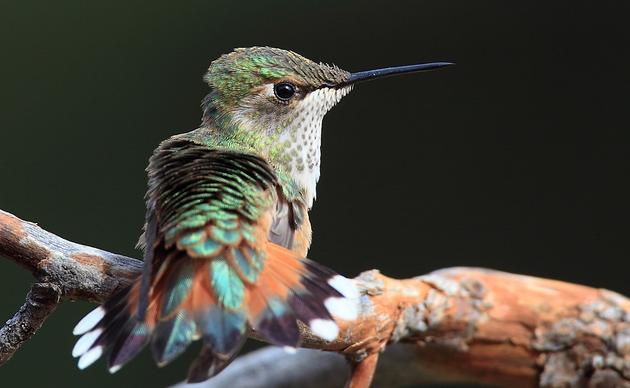A team of researchers across six countries has been investigating how much migratory birds respond to climate change signals. Thanks to more than two decades of shorebird nesting fieldwork, we’re starting to get some answers, as described in the 2024 publication, “Why do avian responses to change in Arctic green-up vary?” Do birds that migrate shorter distances better adapt their nesting schedule to the ever-changing start of spring? Is climate change keeping shorebird parents on their toes? Audubon’s River Gates, Environment and Climate Change Canada’s Kirsty Gurney, and a global group of collaborators battled unseasonable cold snaps and tapped into their collective expertise to find out.
When Spring Has Sprung… Or Not
For birds migrating to Alaska’s Arctic, climate change can be confusing. Warmer winters mean earlier snowmelt, and plants starting their summer growth earlier and earlier. The onset of spring is generally advancing by a couple days per decade. However, as Audubon’s Shorebird Conservation Manager, River Gates, can confirm, the start of spring is anything but certain.
Similar to the shorebirds she was studying, Gates flew north to Alaska’s Cape Krusenstern National Monument and got situated for the spring.
“One season, we arrived and set up camp in warm temperatures, with shorebirds building their nests as usual,” Gates said, “However, in the first week of incubation, we had this really sudden cold snap. Ponds iced over, and birds seemed to say to each other, ‘We can’t pull this off, we’ll just try again a little later.’”
The birds abandoned their nests and took some time to recover. “I swear, the paired males were running around after their female mate, prodding them to eat so they could gain enough energy to lay another clutch of eggs,” Gates recalled.
Fortunately, she found that the vast majority of Dunlin were indeed able to renest despite the delayed start to the spring. This was a major indication to Gates that shorebirds might be more adaptable than people give them credit for.
For birds, the stakes of mistiming migration are high: After journeys spanning thousands of miles, birds arrive with their energy levels at an all-time low. The Arctic summer provides only a narrow window to breed, lay eggs, rear chicks, and fuel up for the journey south before snow starts falling again. If birds arrive too early and find snowfields instead of nutritious insects, the consequences can be extreme. On the other hand, if shorebirds arrive too late for the big spring pulse of food, they might miss their best opportunity to efficiently replenish their depleted fuel.
So, with climate change driving not just earlier springs but also more extreme variability in when spring starts, can tiny shorebirds survive?
This question has been at the forefront of bird researchers’ minds, and observations have started to trickle in.
For example, Gates’ fieldwork allowed her to estimate that up to 95% of Dunlin pairs would renest if their initial clutch of eggs failed during the early season. Relatedly, we’ve seen some signs of birds adjusting phenology (the timing of life history events like migration or laying eggs). But overall, we still don’t know how much capacity birds have to adjust. The current prevailing wisdom is that the more distance a bird has to cover on its migration, the harder it will be for that bird to time its arrival well when it finally reaches its destination—a troubling thought with special significance for birds aiming for Alaska.
Working on an Avian Answer
A team of shorebird specialists set out to answer questions about climate change and when birds nest, publishing their findings in the research article “Why do avian responses to change in Arctic green-up vary?”
The authors consist of 29 researchers, including Gates, U.S. Fish & Wildlife Service’s (USFWS) Alaska Region Shorebird Coordinator Rick Lanctot, USFWS shorebird biologist Sarah Saalfeld, and Environment and Climate Change Canada’s Kirsty Gurney. As Gurney describes it, this massive team grew out of a cutting-edge research collaboration that organically sprang up in response to a need to study shorebirds across their range. Other support came from the Arctic Shorebird Demographics Network, including Lanctot, as well as David Ward and Dave Douglas with the United States Geological Survey (USGS), Steve Brown from Manomet, and Brett Sandercock with the Norwegian Institute for Nature Research.
“This started as a side project from my main post-doctoral focus on Arctic food webs, and kind of snowballed from there,” Gurney said. “When people found out what we were doing, tons of folks reached out to share data.”
Soon, data poured in from a network of bird nesting sites across the world, with intensive fieldwork in Alaska, Canada, Russia, and Greenland. Over 23 years, these researchers logged more than 8,000 nest observations—an exhaustive effort to bring together some of the brightest minds in bird ecology to wrestle with one of the thorniest questions we face in our changing climate.
Using a shared field sampling protocol as a common language across each study site, Gurney and her team linked their accumulated bird data with satellite images of plant green-up, or when new leaves sprout to allow plants to start growing after being dormant over winter. This allowed them to estimate when spring was starting at each location and year. They could then compare this start-of-spring date with when birds began nesting. The idea was to see if birds responded to earlier springs with earlier nesting, and later springs with later nesting. If birds could successfully track such variable conditions, they’d stand a better chance against the capricious nature of climate change.
Meet Your Arctic All-Stars
The selected shorebird species resemble something of an Arctic all-star team: American Golden-Plover, Sanderling, Pectoral Sandpiper, Semipalmated Sandpiper, Western Sandpiper, Red-necked Phalarope, Red Phalarope, and the aforementioned Dunlin, closely watched by Gates.
These birds were chosen because of their diversity in a couple of key biological features: migration distance, parental care, and body mass. Although the 3,600 miles traveled by Dunlin, on average, is staggering by human standards, it barely covers half the migration distance of Pectoral Sandpipers (7,400-plus miles). These long-distance champions are also well-known helicopter parents, with Dunlin spending more than 46 days incubating eggs and rearing chicks. Female phalaropes, in contrast, lay eggs and leave incubation—and parental care—to the males.
Because scientists better understand the migration starting points of Semipalmated Sandpipers, these were nominated as honorary captains to test the theory that diverse populations of the same species respond differently to a changing climate. They were also chosen for their widespread distribution. These diminutive spokesbirds barely tip the scales at 27 grams (less than a slice of bread), as compared to the relatively massive American Golden-Plovers (146 grams; about the weight of a baseball). With these life history traits in mind, Gurney and her collaborators carefully tested how well these traits might prepare shorebirds to respond quickly and effectively to changes in spring conditions.
Their headline finding was surprisingly positive: shorebirds successfully bumped up their nesting dates by zero to 0.4 days per one day of springtime advance, depending on the species. This suggests that, overall, shorebirds are pretty good at synchronizing their breeding schedule with local conditions. Because these tiny travelers live in such an unpredictable environment, it makes sense that they have some ability to change their nest timing.
Our fearless leader—the Semipalmated Sandpiper—was steadfast in their behavior, refusing to budge nesting time regardless of where they’ve come from, and with one of the lowest rates of nest-date-advance. These birds were representative of their fellow short-distance migrants (short-distance is defined here—in another reminder of how impressive shorebirds are—as less than 5,000 miles) in that they appeared least effective in syncing their nesting with spring timing.
Long-distance migrants, on the other hand, appear to be best at matching changing conditions. This is unexpected, somewhat counterintuitive, and leaves us with some urgent and unanswered new questions: Are these species migrating quicker, or breeding quicker? What specific environmental cues are the birds responding to along their journeys and on their breeding grounds? How do they perceive these cues? And, most importantly, will birds run into some biological limit on their ability to change the timing of nesting?
Conservation Past the Finish Line
Aside from the species-specific findings, Gurney highlights some major takeaways about how birds respond to climate change. First, this study speaks to the value being unlocked with long-term research efforts that span national boundaries.
“There’s so much good work being done in the Arctic,” Gurney said, “and the issue of climate change is so cross-cutting that questions of scale come up.”
Gurney points specifically to how they pooled field data as part of the Arctic Shorebird Demographics Network as crucial for their study’s success: The only way to understand truly international birdlife is truly international collaboration. Gurney and her team were able to organize finer-scale individual observations into broader themes. Those Dunlin that Gates watched battle through a spring snowstorm illustrate how short-distance migrants appear to be worse at tracking spring conditions than long-distance migrants like Western or Pectoral sandpipers, a finding that tells a larger story only because of the extensive global network of observations pouring in.
Secondly, “We have a lot to learn about how flexible birds are,” Gurney said. “Even the ‘unresponsive’ species could be responding to something that we’re not measuring, like snow cover or availability of nesting habitat.”
Throughout their migration and breeding seasons, birds’ decision-making remains a complex calculus balancing a huge variety of factors. Gurney, Gates, and their colleagues have figured out that the timing of the start of spring is one of the more important factors, at least for these Arctic shorebirds.
Finally, this paper underscores the importance of spatial conservation so that, when these Arctic migrants do arrive, they find prime nesting spots waiting for them. Whether shorebird breeding is perfectly synchronized with the start of spring or somewhat off-kilter, having a safe place free of disturbances, fewer predators, and full of food is critical.
While some of us struggle to track even a one-hour daylight-saving time switch in spring, Arctic breeding shorebirds seem to be synchronizing their own impressive itineraries with remarkable precision, across thousands of miles and dozens of days. We’re still learning how exactly they shuffle stopovers, pick up their pace, and adjust energy expenditure as they aim for their Arctic finish line.
But we know we need to provide a safe place for shorebirds to recover and nest once their annual migratory race has been run.




